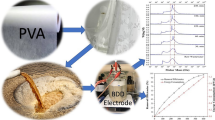Abstract
The pretreatment of refractory polyvinyl-alcohol (PVA) wastewater with low value of CODCr by Fenton’s reagent was investigated to enhance the biodegradability. The effects of operating conditions such as pH of the solution, Fe2+ dosage, H2O2 dosage, reaction time and initial PVA concentration on the removal efficiency of CODCr were discussed. It is demonstrated that the optimum value of pH for removal of CODCr is 5 and the most suitable dosages of H2O2 (2%) and FeSO4 (10 mg/L) are 5% and 8.0%, respectively. When the initial CODCr value of the PVA water is 760 mg/L, the favorable reaction time is 110 min. Under these optimum conditions, the removal ratio of CODCr is 58.6%–61.4%, and the value of biodegradability (CODB/CODCr) increases markedly from 8.9%–9.7% to 62.6%–68.3%.
Similar content being viewed by others
References
GIROTO J A, GUARDANI R, TEIXEIRA A C S C, NASCIMENTO C A O. Study on the photo-Fenton degradation of polyvinyl alcohol in aqueous solution [J]. Chemical Engineering and Processing, 2006, 45(7): 523–532.
TOKIWA Y, KAWABATA G, JARERAT A. A modified method for isolating poly(vinyl alcohol)-degrading bacteria and study of their degradation patterns [J]. Biotechnology Letters, 2001, 23(23): 1937–1941.
DEMERLIS C C, SCHONEKER D R. Review of the oral toxicity of polyvinyl alcohol (PVA) [J]. Food and Chemical Toxicology, 2003, 41(3): 319–326.
XU Jin-lan, HUANG Ting-ling, WANG Zhi-ying. Biodegradation of PVA in an anaerobic baffled reactor [C]// Future of Urban Wastewater Systems—Decentralisation and Reuse. Beijing: China Architecture & Building Press, 2005: 429–436.
CHOI K K, PARK C W, KIM S Y, LYOO W S, LEE S H, LEE J W. Polyvinyl alcohol degradation by microbacterium barkeri KCCM 10507 and paeniblacillus amylolyticus KCCM 10508 in dyeing wastewater [J]. Journal of Microbiology and Biotechnology, 2004, 14(5): 1009–1013.
LIM J G, PARK D H. Degradation of polyvinyl alcohol by brevibacillus laterosporus: Metabolic pathway of polyvinyl alcohol to acetate [J]. Journal of Microbiology and Biotechnology, 2001, 11(6): 928–933.
CORTI A, SOLARO R, CHIELLINI E. Biodegradation of poly-(vinyl alcohol) in selected mixed microbial culture and relevant culture filtrate [J]. Polymer Degradation and Stability, 2002, 75(3): 447–458.
SOLARO R, CORTI A, CHILLINI E. Biodegradation of poly(vinyl alcohol) with different molecular weights and degree of hydrolysis [J]. Polymers for Advanced Technologies, 2000, 11(8/12): 873–878.
CHEN Ying-xu, SUN Zhen-shi, YANG Ye, KE Qiang. Heterogeneous photocatalytic oxidation of polyvinyl alcohol in water [J]. Journal of Photochemistry and Photobiology A—Chemistry, 2001, 142(1): 85–89.
GRONROOS A, PIRKONEN P, HEIKKINEN J, IHALAINEN J, MURSUNEN H, SEKKI H. Ultrasonic depolymerization of aqueous polyvinyl alcohol [J]. Ultrasonics Sonochemistry, 2001, 8(3): 259–264.
ZHANG Shu-juan, YU Han-qing. Radiation-induced degradation of polyvinyl alcohol in aqueous solutions [J]. Water Research, 2004, 38(2): 309–316.
de BUSSETTI S G, FERREIRO E A. Adsorption of poly(vinyl alcohol) on montmorillonite [J]. Clays and Clay Minerals, 2004, 52(3): 334–340.
BEHERA S K, KIM J H, GUO X J, PARK H S. Adsorption equilibrium and kinetics of polyvinyl alcohol from aqueous solution on powdered activated carbon [J]. Journal of Hazardous Materials, 2008, 153(3): 1207–1214.
BHARGAVA S K, TARDIO J, PRASAD J, FOGER K, AKOLEKAR D B, GROCOTT S C. Wet oxidation and catalytic wet oxidation [J]. Industrial & Engineering Chemistry Research, 2006, 45(4): 1221–1258.
SUAREZ-OJEDA M E, STÜBER F, FORTUNY A, FABREGAT A, CARRERA J, FONT J. Catalytic wet air oxidation of substituted phenols using activated carbon as catalyst [J]. Applied Catalysis B— Environmental, 2005, 58(1/2): 105–114.
GOMES H T, FIGUEIREDO J L, FARIA J L. Catalytic wet air oxidation of olive mill wastewater [J]. Catalysis Today, 2007, 124(3/4): 254–259.
CHEN Peng, FANG Fang, GUO Jin-song, LIU Guo-qiang. Removal characteristic of landfill leachate by Fenton reagent [J]. Journal of Central South University of Technology, 2007, 14(Suppl. 3): 490–494.
HEREDIA J B, DOMINGUEZ J R, LOPEZ R. Advanced oxidation of cork-processing wastewater using Fenton’s reagent: Kinetics and stoichiometry [J]. Journal of Chemical Technology and Biotechnology, 2004, 79(4): 407–412.
POSADA D, BETANCOURT P, LIENDO F, BRITO J L. Catalytic wet air oxidation of aqueous solutions of substituted phenols [J]. Catalysis Letters, 2006, 106(1/2): 81–88.
RODRIGUES C S D, MADEIRA L M, BOAVENTURA R A R. Optimization of the azo dye Procion Red H-EXL degradation by Fenton’s reagent using experimental design [J]. Journal of Hazardous Materials, 2009, 164(2/3): 987–994.
FONGSATITKUL P, ELEFSINIOTIS P, YAMASMIT A, YAMASMIT N. Use of sequencing batch reactors and Fenton’s reagent to treat a wastewater from a textile industry [J]. Biochemical Engineering Journal, 2004, 21(3): 213–220.
TEKIN H, BILKAY O, ATABERK S S, BALTA T H, CERIBASI I H, SANIN F D, DILEK F B, YETIS U. Use of Fenton oxidation to improve the biodegradability of a pharmaceutical wastewater [J]. Journal of Hazardous Materials, 2006, 136(2): 258–265.
MARTINEZ N S S, FERNÁNDEZ J F, SEGURA X F, FERRER A S. Pre-oxidation of an extremely polluted industrial wastewater by the Fenton’s reagent [J]. Journal of Hazardous Materials, 2003, 101(3): 315–322.
TANTAK N P, CHAUDHARI S. Degradation of azo dyes by sequential Fenton’s oxidation and aerobic biological treatment [J]. Journal of Hazardous Materials, 2006, 136(3): 698–705.
WANG Kang-le, LIU Sui-qing, ZHANG Qiang, HE Yi-liang. Pharmaceutical wastewater treatment by internal micro-electrolysis-coagulation, biological treatment and activated carbon adsorption [J]. Environmental Technology, 2009, 30(3): 1469–1474.
Author information
Authors and Affiliations
Corresponding author
Additional information
Foundation item: Project(08JCYBJC02600) supported by the Natural Science Foundation of Tianjin, China; Project(2008ZX07314-005-011) supported by the National Major Technological Program of China
Rights and permissions
About this article
Cite this article
Xiao, Yt., Xu, Ss. & Li, Zh. Degradation of polyvinyl-alcohol wastewater by Fenton’s reagent: Condition optimization and enhanced biodegradability. J. Cent. South Univ. Technol. 18, 96–100 (2011). https://doi.org/10.1007/s11771-011-0665-y
Received:
Accepted:
Published:
Issue Date:
DOI: https://doi.org/10.1007/s11771-011-0665-y




